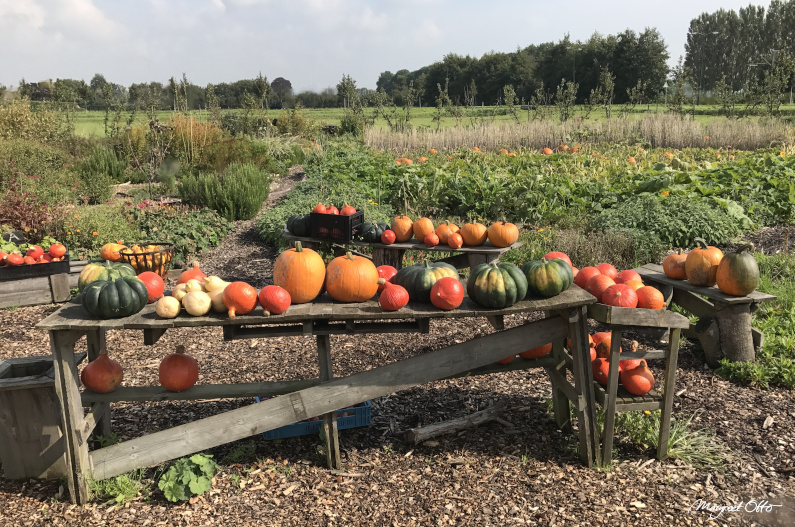HOW TO GROW PUMPKINS…
Have you considered growing pumpkins and squashes on your kin domain? One can grow them in an allotment or vegetable garden, but these are also great vegetables to grow as a crop on lets say half of a hectare, or that one acre of your homestead. Especially for those who do not have the experience of growing vegetables, the choice for pumpkins might provide a relativly easy start. It’s fun for children too. There are many things one needs to know however to make it into a succes. The first thing to know is what is your motivation to grow pumpkins. Do you feel inclined to do it? If yes, you might want to know how to grow them!
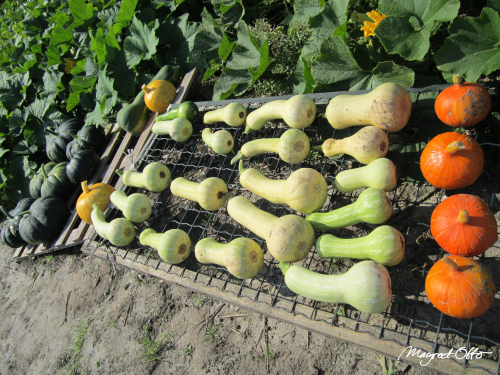
The Advantage Of Growing Pumpkins
To start with, pumpkins and winter squashes are a delicious versatile vegetable-fruit! Many people love the taste and the many dishes that can be made out of it, such as pumpkin soup, pumpkin Thanksgiving pie, pumpkin stew, pumpkin quiche, muffins, etcetera.
But oftentimes people think they’re a bit pricey as not many farmers are growing them. So instead of consuming pumpkin once or twice a week, they only consume it once a month. If more farmer families would grow pumpkin though, it would lower the prices, thus they can be consumed more often, and even fed to lifestock, who love it too.

A baby pumpkin growing from a fertilized flower by bees,
this one looks like the edible Pattison pumpkin (Cucurbita pepo),
but might as well be a non edible ornamental pumpkin, which will remain small.
Survival Food
Another reason you might want to prefer growing pumpkins is that they’re also a great survival food. They can be stored for a long time and maintain their freshness and nutrition density. They’re still fresh even after half a year with the right proper storage. This is unusual in winter time when there are less fresh grown foods available.
Nutrient Dense
And pumpkin is very nutrient dense, it has a lot of vitamins and minerals: vitamin A, B2, C, E, riboflavin, potassium, copper, iron, manganese. Per 100 grams of pumpkin there are 26 calories, consisting of 84% carbs, 13% proteïn and 3% fat and 2% dietary fiber. And for the preparation of dishes, as they are high in carbs, they might partially replace potatoes. Pumpkins also grow easy with a little care and knowledge.

These are large gourds, also known as ‘kalebassen’ or ‘calabash’.
Some have names such as ‘muscat pumpkin’, not sure what this variety is, but edible.
Storage Of Pumpkin
It is kind of strange that pumpkins are a bit pricey, because they are a relativly easy to grow vegetable and can be stored without any extra costs. They need to be stored in a cool room, preferably around 41F or 5C, but not with freezing conditions. When frozen, they will go bad quickly afterwards. Therefore it is important to pay attention to the temperature regulation.
Storage Without Electricity
In the past, old Dutch farmhouses would have good ventilated underground cellars where they could store potatoes, pumpkins and the likes without electricity for refrigeration. Unheated hay barns in autumn are also a perfect storage place, but when temperatures go below 32F, other solutions must be found for the vegetables.
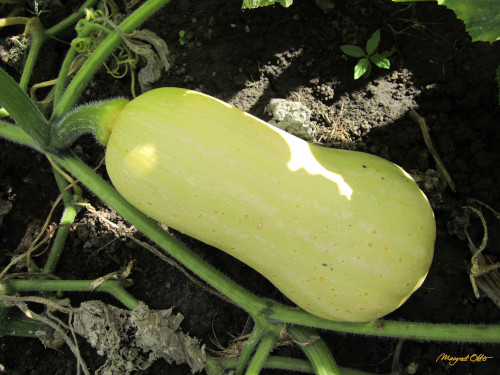
Another pumpkin species, the bottle gourd
How To Get Seeds
It is also easy to get seeds, there are basically two ways to get them: by collecting a pumpkin which has seeds in it, or buying the seeds in a store or online.
– Buying Seeds
Are you buying the seeds from an organic grower? Then one knows for sure that the seeds will grow the same pumpkins as depicted on the package. But there are a few things one needs to know regarding this. Such as when these seeds are planted and grown in an allotment or small veggie plot. If there are other vegetable gardeners who grow different species of pumpkins, the plants might get cross pollinated. Those might give a mixture pumpkin-fruit of two pumpkin species. The mixed pumpkins will be of an uncertain outcome, their taste, color, structure and size can be affected.
So even if one buys authentic heirloom seeds, this can still happen. It is more likely that the same kind of pumpkin species would stay intact though on half of a hectare field, or like one and a half acres. On such scale there is no cross pollination (unless the neighbouring farm is growing a different pumpkin variety. Then some pumpkins on the edge of the fields might still become mixed, although bees can fly many miles).

The green pumpkin Hokkaido Cucurbita has the sweetest fruit-flesh, and actually tastes better compared to the orange ones. But the edible orange ones do have such great ornamental value as well! The flesh of the green pumpkin is also orange however. When soup is made of it, the soup will turn orange if the peel isn’t cooked with it. The peel is edible also though.
– Seeds From Pumpkins
When one collects the seeds from the pumpkins themselves, e.g. from pumpkins bought in a grocery store, the seeds might already be the result of cross pollination. If the pumpkins are grown by a commercial organic farmer, the chances are scarce though, because the farmer has most likely opted to grow one pumpkin species on his land to get the best pumpkins. He might also have harvested new seeds from some of those for growing pumpkins next season.

From this flower another pumpkin will grow.
For collecting seeds from pumpkins, all you have to do is prepare a few meals in autumn or winter with pumpkin. Each time when preparing the pumpkin, usually the first thing to do is to cut it in half. Then the seeds in the middle become visible. Scoup out the seeds with a table spoon or your hands, and put them in a bowl of water. Then put your hand in the water and gently rub the flesh of the pumpkin seeds while they are in the water. This is the easiest way to clean them. If you wait too long with putting the seeds in water, the flesh will get sticky and hard to remove. It’s a bit time consuming so one needs a little bit of patience to do it.
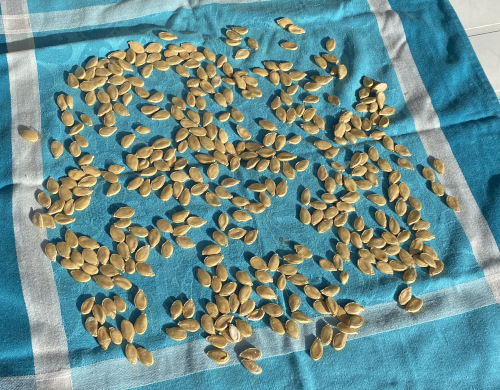
pumpkin seeds to dry on a kitchen towel
Storage Of Seeds & Growing
Then, how to dry and store the seeds? When most of the flesh is removed, one can put the seeds on a kitchen towel to dry. Put the towel near a heating, or with warm weather outside in the sun. It takes around three days to fully dry. The seeds can be turned one or two times to let the moist escape that is beneath the seed on the towel.
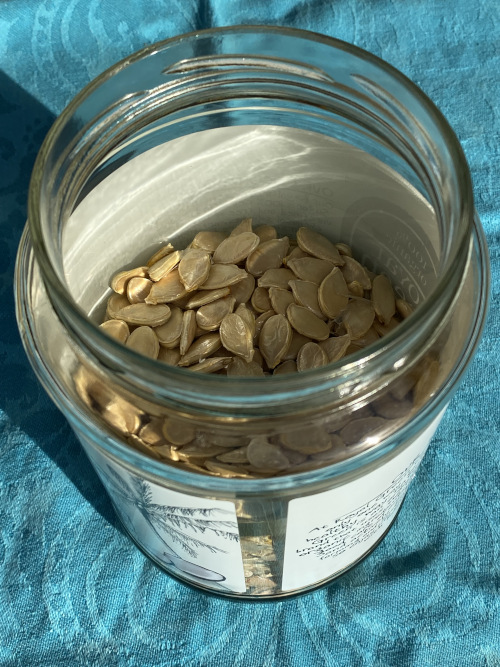
pumpkin seeds storage
After the pumpkin seeds have dried they can be stored in a container until they can be sown the next season or next year. Depicted above is a glas jar with the seeds of three pumpkins in it. Basically, half a hectare can be sown with a full jar like this! Because from every seed grows a pumpkin plant which will usually bear around 5 to 8 pumpkins. The amount of pumpkins depend on their size, the specific species, the soil, the weather and how the plant is treated and fertilized.
Full grown pumpkin plants have large leaves so they can catch lots of sunshine. The plant can utilize this sun energy combined with rainwater or fresh water through a proces of photosynthesis. This way the sugar and carbohydrates in the fruit-vegetable is formed. If you have never tasted one, they’re like carrot but sweeter. And they have a softer puree texture as well once cooked.

The leaves of the Orange Hokkaido Pumpkin catching sunlight.
Preparing The Ground
There are different methods to prepare the ground. Some people will plow the soil in the spring and then fertilize it with organic fertilizer and compost. Others choose not to plow the soil but to create a top layer of diverse organic plant material, and use compost and organic fertilizer as well. Both methods require physical labor and also enough supply of organic composted material and organic fertilizer to work with.
One can use autumn and early winter to collect all needed materials. If there have been crops growing on the land the previous year, the soil needs to be fertilised after plowing, or fertilized when preparing the soil as it is kept whole. You can chose the method of your preference! See the article SOW THE LAND for more information on preparing the ground and organic fertilizer.

Large Orange Pumpkin
Growing Season
Once the temperature goes up in spring, pumpkins grow rapidly. The plant stems spread over the ground and take up a lot of space. Also the pumpkins theirselves grow voluminous in size. They can take up the size of a football, and even much larger specimen have grown. Sometimes there are contests in area’s where the growing season is long and the climate ideal. Then they might grow up to a man’s knees or even taller!

Here you can see the difference in size and color of several pumpkin species.
These are some serious babes!
Therefore the plants need lots of nutrition. The plant loves organic compost and plant fertilizer. But don’t worry, the compost and fertilizer won’t enter the actual pumpkins, but its minerals are absorbed by the plants in the early stage of growth to form the leaves and stems.

3 bottle gourds.
another lookalike variety with a light orange colour is called butternut squash, not depicted here.
Try Pumpkins
Contemplating this, pumpkins might be a great food to grow on a larger scale than they currently are. They are relativly easy and cheap to grow in the Northern Hemisphere. And there are many crops that don’t grow overhere unfortunately, such as the many sweet fruit varieties, those need a warmer climate such as the mediterranean weather. But not pumpkins!
When grown in abundance in the hectares villages, there’ll be an overload for what the habitants of the hectares village may consume. Thus citizens in cities can also be nourished by them. Food might become FREE in the future!

These are non edible ornamental gourds.
They are nice for decoration in- and around the house in autumn!
Division of Labor and Land
Technically, when using half a hectare of every hectare for growing crops, a village of 150 hectares, minus 10 acres in the center, has 70 hectares, thus around 170 acres available for growing pumpkins or any other crops that the residents choose. Thus instead of one farmer managing 100 hectares of land as it was happening in the recent past, now we have 100 families running the hectares, each couple or family their own little paradise!
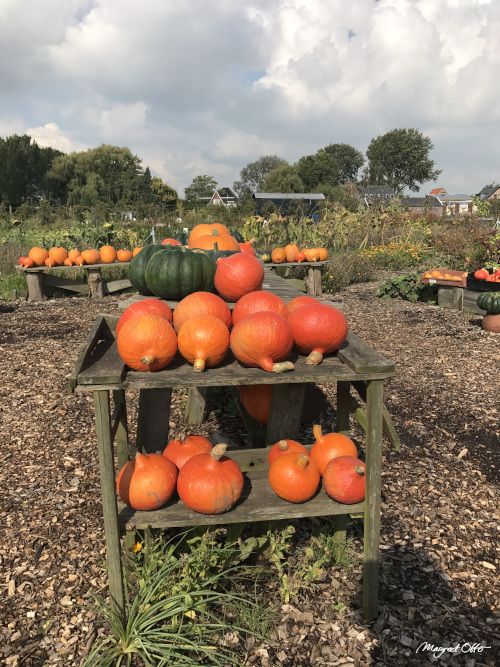
It Takes A Village
The expression that a village is needed to raise a child, applies in a certain way also to other activities in a village, where communal labour, or some form of barter labour, is much more self-evident, and of course takes place always in good consultation, with good planning and recording of agreements.
With harvesting for example, the villagers can take turns helping each other and this automatically creates solidarity in the hectares village or settlement. Harvest festivals will be held, and special dishes prepared, such as the famous pumpkin pies. Basically there are festivities for all seasons, less commercialised than we know them nowadays, but more connected to the land, to nature, and to each other.
*******
Back to MENU

